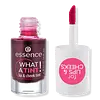What's inside
What's inside
 Key Ingredients
Key Ingredients

 Benefits
Benefits

 Concerns
Concerns

No concerns
 Ingredients Side-by-side
Ingredients Side-by-side

Water
Skin ConditioningGlycerin
HumectantPropanediol
SolventBetaine
Humectant1,2-Hexanediol
Skin ConditioningPanthenol
Skin ConditioningSodium Hyaluronate
HumectantLeuconostoc/Radish Root Ferment Filtrate
AntimicrobialXanthan Gum
EmulsifyingVaccinium Macrocarpon Fruit Extract
AstringentEthylhexylglycerin
Skin ConditioningLactic Acid
BufferingSodium Hydroxide
BufferingCitric Acid
BufferingPhenoxyethanol
PreservativeParfum
MaskingCI 16035
Cosmetic ColorantCI 42090
Cosmetic ColorantCI 45410
Cosmetic ColorantIsononyl Isononanoate
EmollientIsododecane
EmollientPolybutene
Hydrogenated Styrene/Isoprene Copolymer
Silica Silylate
EmollientPolyethylene
AbrasiveTrimethylsiloxysilicate
EmollientPhenoxyethanol
PreservativePunica Granatum Seed Oil
EmollientRosa Rubiginosa Seed Oil
EmollientTocopheryl Acetate
AntioxidantCarthamus Tinctorius Seed Oil
MaskingCitrus Medica Vulgaris Fruit Extract
AntioxidantPentaerythrityl Tetra-Di-T-Butyl Hydroxyhydrocinnamate
AntioxidantCI 77891
Cosmetic ColorantCI 77491
Cosmetic ColorantCI 77492
Cosmetic ColorantCI 77499
Cosmetic ColorantCI 15850
Cosmetic ColorantCI 15985
Cosmetic ColorantIsononyl Isononanoate, Isododecane, Polybutene, Hydrogenated Styrene/Isoprene Copolymer, Silica Silylate, Polyethylene, Trimethylsiloxysilicate, Phenoxyethanol, Punica Granatum Seed Oil, Rosa Rubiginosa Seed Oil, Tocopheryl Acetate, Carthamus Tinctorius Seed Oil, Citrus Medica Vulgaris Fruit Extract, Pentaerythrityl Tetra-Di-T-Butyl Hydroxyhydrocinnamate, CI 77891, CI 77491, CI 77492, CI 77499, CI 15850, CI 15985
 Reviews
Reviews

Ingredients Explained
These ingredients are found in both products.
Ingredients higher up in an ingredient list are typically present in a larger amount.
Phenoxyethanol is a preservative that has germicide, antimicrobial, and aromatic properties. Studies show that phenoxyethanol can prevent microbial growth. By itself, it has a scent that is similar to that of a rose.
It's often used in formulations along with Caprylyl Glycol to preserve the shelf life of products.